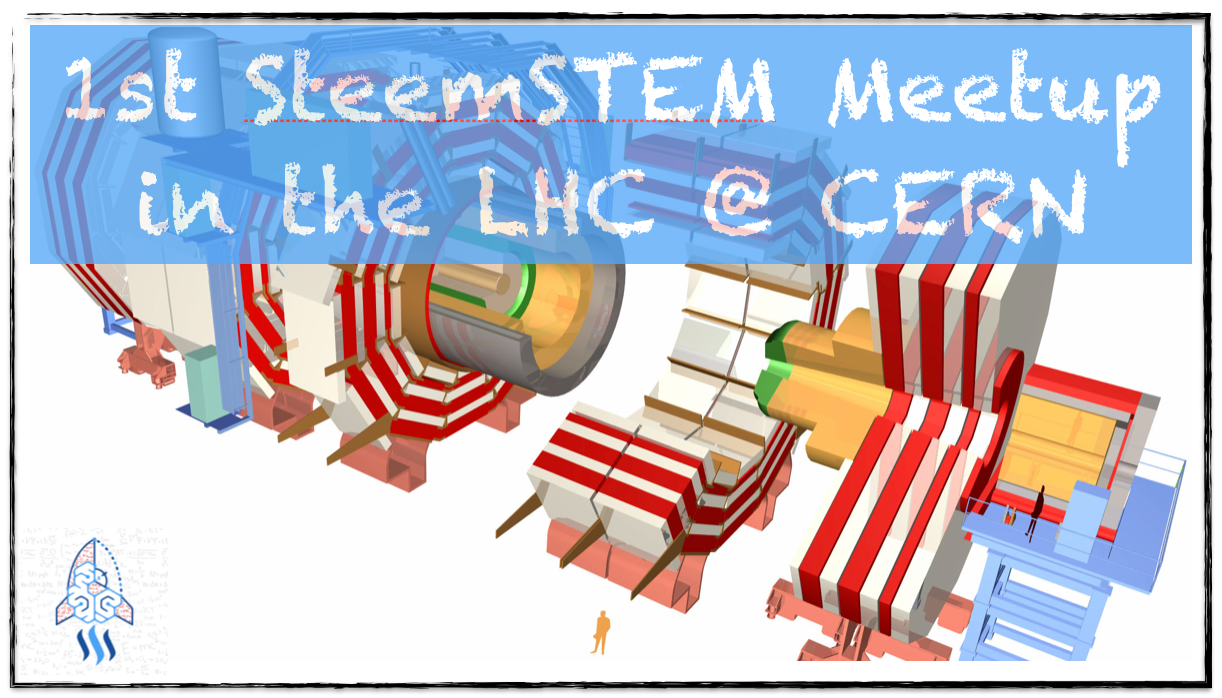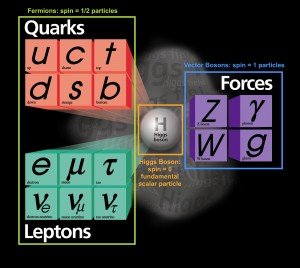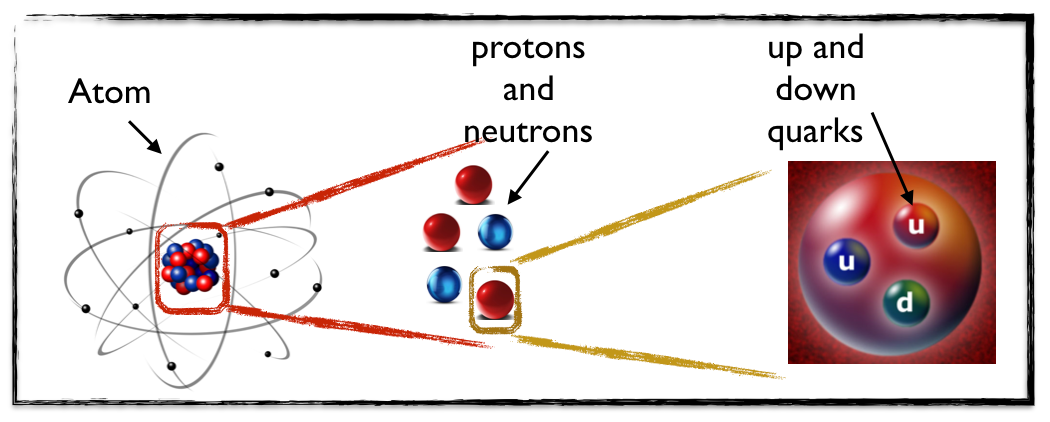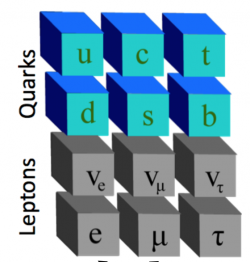Between 15 and 20 Steemians will soon meet at CERN to visit the place and go down to see, with their own eyes, the CMS detector of the Large Hadron Collider (and the collider itself too). Thanks to Steemit and steemSTEM, the participants to the meetup will hence be able to see, from very close, one of the largest experimental complex ever built by humans.
See here for more information on the meetup.
CMS is represented in the picture below where a human being is also shown for the sake of the comparison. The detector consists in a huge beast of 14000 tons that has a length of 28.7 meters and a diameter of 15 meters. We will be able to see it very closely in 3 weeks. By the way, the ‘C’ in the acronym stands for ‘compact’… The detector is indeed small in size, in particular compared to its brother ATLAS.

In order to prepare this visit, I decide to start writing a bunch of posts that will explain what we do there, how particle physics works and how the LHC works. I hope this will be useful not only for those attending the meetup, but also for anyone who would like to get some particle physics introduction.
The slides to be presented within a complete presentation at the meetup and that correspond to this post are available here.
THE STRUCTURE OF MATTER
The LHC and the associated experiments aim to probe better the fundamental laws of nature. This means both verifying the Standard Model of particle physics and trying to unravel new phenomena that will demonstrate that the Standard Model has to be extended to some more fundamental theory.

[image credits: Fermilab]
But before explaining how the Standard Model is probed at the LHC (in future posts), I will describe what the Standard Model is.
In one sentence, the Standard Model describes the laws and the properties of the world of the elementary particles, as could be guessed from the above text.
And the elementary particles that we are interested in are those shown in the picture on the left.
In order to describe all these particles, it is good to start from things we all know: an atom.
Since the 1910s (the work of Rutherford), we know that atoms are made of a nucleus, located in a very dense zone at the center of the atom, and of peripheral electrons. Whilst there is no proof that electrons possess a substructure (from indirect measurements of their magnetic moment), there is in contrast observations that atomic nuclei are not fundamental objects.
Those atomic nuclei are indeed all made of neutrons and protons, as discovered during the 20 years that followed the discovery of the atomic structure by Rutherford.
Protons consist in (one of) the stuff that is accelerated, arranged in collimated beams inside the LHC and smashed.
However, the story does not end here. By studying the scattering of electrons from protons and neutrons, it has been found that those particles are also composite objects. The entities making up the protons and the neutrons are called quarks, and we need two species of them to form neutrons and protons: up quarks and down quarks.
All of this is summarized in the below picture.

[image credits: homemade (from stuff available everywhere)]
One can notice in the picture that the proton is shown as made of two up quarks and one down quark. That is of course a too simplistic picture for what concerns the LHC. But this is for the next posts, when I will discuss LHC collisions. In short, we can say that the proton is in reality some very complex stuff.
Although we may want to go deep inside the quarks, there is currently no experimental sign of a quark substructure. We can thus stop here.
We have so far introduced three fundamental particles that explain how matter is made of: the up and down quarks, and the electron.
NEUTRINOS
So far, we have met three particles. But there is actually a fourth important fundamental guy, the neutrino. Its existence was unravelled in the study f radioactive beta decays at the beginning of the 20th century.

[image credits: homemade]
The neutrino was postulated (and then discovered) in order to explain the corresponding data. The beta decay mechanism, at the atomic level, is summarized on the right.
The represented atomic nucleus sees one of his constituting protons becoming a neutron, which happens together with the emission for an electron and a neutrino.
Without the neutrino, the energy of the electron has to be equal to a single well-defined value E. When studying data, the energy can however take a lot of values, ranging from 0 to E. The presence of the neutrino allows this, the available energy being then shared between the electron and the neutrino.
We have thus four elementary particles: the up quark, the down quark, the electron and the neutrino. This is what is called the first generation of elementary fermions.
BEYOND THE STRUCTURE OF MATTER: THE NUMBER 3
One concept is important in the last sentence above: the wording first generation. This means we have other generations of fermions. Nature was nice enough to make two extra copies of these 4 particles (the up and down quarks, the electron and the (actually electronic) neutrino), so that we end up with 12 elementary fermions.

[image credits: unknown (everywhere on the web)]
Those 12 guys are shown on the left. We have three up-type quarks (up, charm and top), three down-type quarks (down, strange and bottom), three charged leptons (electron, muon and tau) and three neutrinos. In addition, all of these guys come with their own antiparticle.
The only difference between the properties of the particles in two different columns consists of their mass. The second column is heavier than the first one, and the third column is heavier than the second one. The rest is identical.
Why three? Well, if you know, you may get the Nobel prize. This is question a good bunch of researchers are trying to answer today. This is something on which I have never personally worked.
The only certainty of today is that we have three of such copies in total. Not four. Not two. We can however have other fermions. But those must have different properties when compared to the Standard Model fermions.
SUMMARY
I started a series of post preparing the meetup, in order to get well prepared to what will be seen. In this post, I started to describe the Standard Model of particle physics and focus on the structure of matter, showing how the connection between the 12 elementary fermions and atoms work.
The slides that I will present during my presentation at the meetup are available here.
More information can also be found in many textbooks. For non-specialists, I recommend this one, from the Nobel prize winner M. Veltman.
SteemSTEM
SteemSTEM is a community-driven project that now runs on Steemit for more than a year. We seek to build a community of science lovers on Steemit and to promote well written/informative Science Technology Engineering and Mathematics (STEM) postings in order to make Steemit a place for fascinating STEM content.
More information can be found on the @steemstem blog, on Discord and on the Steemit chat.
